Great Pyramid of Giza › Ten Noble and Notorious Women of Ancient Greece » Origins and History
Articles and Definitions › Contents
- Great Pyramid of Giza › Ancient History
- Ten Noble and Notorious Women of Ancient Greece › Antique Origins
Ancient civilizations › Historical places, and their characters
Great Pyramid of Giza › Ancient History
Definition and Origins
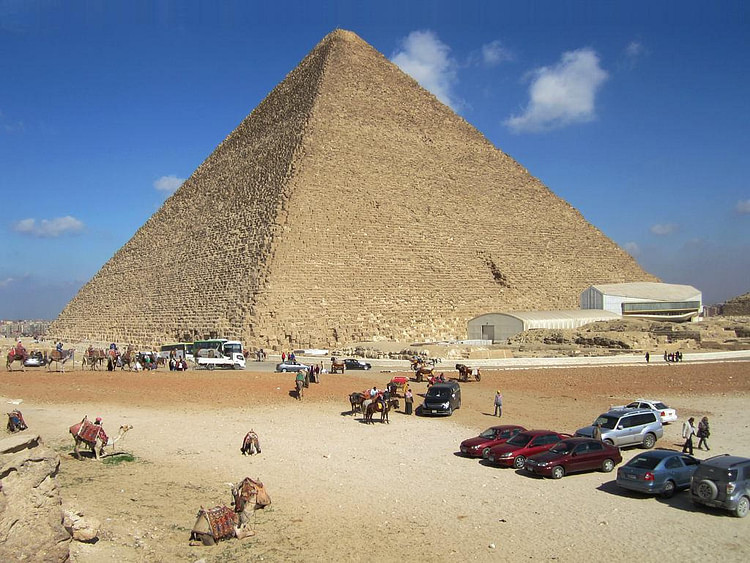
The Great Pyramid of Giza is a defining symbol of Egypt and the last of the ancient Seven Wonders of the World. It is located on the Giza plateau near the modern city of Cairo and was built over a twenty-year period during the reign of the king Khufu (2589-2566 BCE, also known as Cheops) of the 4th Dynasty. Until the Eiffel Tower was completed in Paris, France in 1889 CE, the Great Pyramid was the tallest structure made by human hands in the world; a record it held for over 3,000 years and one unlikely to be broken. Other scholars have pointed to the Lincoln Cathedral spire in England, built in 1300 CE, as the structure which finally surpassed the Great Pyramid in height but, still, the Egyptian monument held the title for an impressive span of time. The pyramid rises to a height of 479 feet (146 metres) with a base of 754 feet (230 metres) and is comprised of over two million blocks of stone. Some of these stones are of such immense size and weight (such as the granite slabs in the King's Chamber) that the logistics of raising and positioning them so precisely seems an impossibility by modern standards.
The pyramid was first excavated using modern techniques and scientific analysis in 1880 CE by Sir William Matthew Flinders Petrie (1853-1942 CE), the British archaeologist who set the standard for archaeological operations in Egypt generally and at Giza specifically. Writing on the pyramid in 1883 CE, Flinders Petrie noted:
The Great Pyramid has lent its name as a sort of by-word for paradoxes; and, as moths to a candle, so are theorisers attracted to it (1).
ALTHOUGH MANY THEORIES PERSIST AS TO THE PURPOSE OF THE PYRAMID, THE MOST WIDELY ACCEPTED UNDERSTANDING IS THAT IT WAS CONSTRUCTED AS A TOMB FOR KING KHUFU.
Although many theories persist as to the purpose of the pyramid, the most widely accepted understanding is that it was constructed as a tomb for the king. Exactly how it was built, however, still puzzles people in the modern day. The theory of ramps running around the outside of the structure to move the blocks into place has been largely discredited. So-called "fringe" or "New Age" theories abound, in an effort to explain the advanced technology required for the structure, citing extra-terrestrials and their imagined frequent visits to Egypt in antiquity. These theories continue to be advanced in spite of the increasing body of evidence substantiating that the pyramid was built by the ancient Egyptians using technological means which, most likely, were so common to them that they felt no need to record them. Still, the intricacy of the interior passages, shafts, and chambers (The King's Chamber, Queen's Chamber, and Grand Gallery) as well as the nearby Osiris Shaft, coupled with the mystery of how the pyramid was built at all and its orientation to cardinal points, encourages the persistence of these fringe theories.
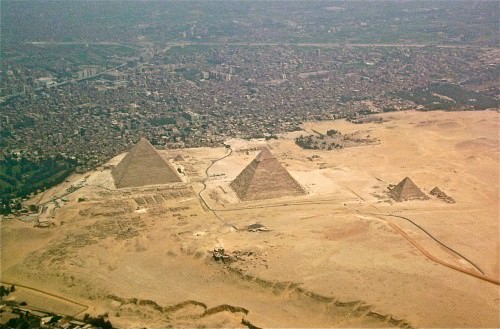
The Pyramids of Giza
PYRAMIDS & THE GIZA PLATEAU
Toward the end of the Early Dynastic Period (c. 3150-c.2613 BCE) the vizier Imhotep ((c. 2667-2600 BCE) devised a means of creating an elaborate tomb, unlike any other, for his king Djoser. Prior to Djoser's reign (c. 2670 BCE) tombs were constructed of mud fashioned into modest mounds known as mastabas. Imhotep conceived of a then-radical plan of not only building a mastaba out of stone but of stacking these structures on top of one another in steps to create an enormous, lasting, monument. His vision led to the creation of Djoser's Step Pyramid at Saqqara, still standing in the present day, the oldest pyramid in the world.
Still, the Step Pyramid was not a "true pyramid" and, in the period of the Old Kingdom (c. 2613-2181 BCE) the king Sneferu (c. 2613-2589 BCE) sought to improve on Imhotep's plans and create an even more impressive monument. His first attempt, the Collapsed Pyramid at Meidum, failed because he departed too widely from Imhotep's design. Sneferu learned from his mistake, however, and went to work on another - the Bent Pyramid - which also failed because of miscalculations in the angle from base to summit. Undeterred, Sneferu took what he learned from that experience and built the Red Pyramid, the first true pyramid constructed in Egypt.
Building a pyramid required enormous resources and the maintenance of a wide array of all kinds of skilled and unskilled workers. The kings of the 4th Dynasty - often referred to as "the pyramid builders" - were able to command these resources because of the stability of the government and the wealth they were able to acquire through trade. A strong central government, and a surplus of wealth, were both vital to any efforts at pyramid building and these resources were passed from Sneferu, upon his death, to his son Khufu.
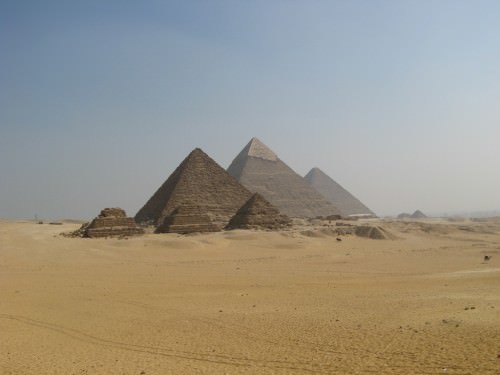
The Pyramids of Giza
Khufu seems to have set to work on building his grand tomb shortly after coming to power. The rulers of the Old Kingdom governed from the city of Memphis and the nearby necropolis of Saqqara was already dominated by Djoser's pyramid complex while other sites such as Dashur had been used by Sneferu. An older necropolis, however, was also close by and this was Giza. Khufu's mother, Hetepheres I (c. 2566 BCE), was buried there and there were no other great monuments to compete for attention close by; so Khufu chose Giza as the site for his pyramid.
CONSTRUCTION OF THE PYRAMID
The first step in constructing a pyramid, after deciding upon the best location, was organizing the crews and allocating resources and this was the job of the second-most powerful man in Egypt, the vizier. Khufu's vizier was Hemiunu, his nephew, credited with the design and building of the Great Pyramid. Hemiunu's father, Nefermaat (Khufu's brother) had been Sneferu's vizier in his pyramid-building projects and it is probable he learned a great deal about construction from these experiences.
The vizier was the final architect of any building project and had to delegate responsibility for materials, transport, labor, payments and any other aspect of the work. Written receipts, letters, diary entries, official reports to and from the palace all make clear that a great building project was accomplished at Giza under Khufu's reign but not one of these pieces of evidence suggest exactly how the pyramid was created. The technological skill evident in the creation of the Great Pyramid still mystifies scholars, and others, in the present day. Egyptologists Bob Brier and Hoyt Hobbs comment on this:
Because of their immense size, building pyramids posed special problems of both organization and engineering.Constructing the Great Pyramid of the pharaoh Khufu, for example, required that more than two million blocks weighing from two to more than sixty tons be formed into a structure covering two football fields and rising in a perfect pyramidal shape 480 feet into the sky. Its construction involved vast numbers of workers which, in turn, presented complex logistical problems concerning food, shelter, and organization. Millions of heavy stone blocks needed not only to be quarried and raised to great heights but also set together with precision in order to create the desired shape. (217)
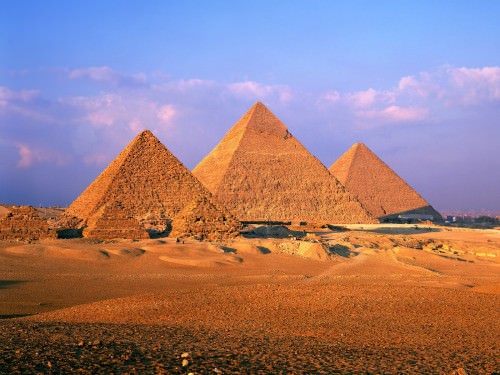
The Pyramids of Giza
It is precisely the skill and technology required to "create the desired shape" which presents the problem to anyone trying to understand how the Great Pyramid was built. Modern-day theories continue to fall back on the concept of ramps which were raised around the foundation of the pyramid and grew higher as the structure grew taller. The ramp theory, largely discredited but still repeated in one form or another, maintains that, once the foundation was firm these ramps could have easily been raised around the structure as it was built and provided the means for hauling and positioning tons of stones in precise order.Aside from the problems of a lack of wood in Egypt to make an abundance of such ramps, the angles workers would have had to move the stones up, and the impossibility of moving heavy stone bricks and granite slabs into position without a crane (which the Egyptians did not have), the most serious problem comes down to the total impracticability of the ramp theory. Brier and Hobbs explain:
The problem is one of physics. The steeper the angle of an incline, the more effort necessary to move an object up that incline. So, in order for a relatively small number of men, say ten or so, to drag a two-ton load up a ramp, its angle could not be more than about eight percent. Geometry tells us that to reach a height of 480 feet, an inclined plane rising at eight percent would have to start almost one mile from its finish. It has been calculated that building a mile-long ramp that rose as high as the Great Pyramid would require as much material as that needed for the pyramid itself - workers would have had to build the equivilent of two pyramids in the twenty-year time frame. (221)
A variation on the ramp theory was proposed by the French architect Jean-Pierre Houdin who claims ramps were used inside of the pyramid. Houdin believes that ramps may have been used externally in the initial stages of construction but, as the pyramid grew taller, work was done internally. The quarried stones were brought in through the entrance and moved up the ramps to their position. This, Houdin claims, would account for the shafts one finds inside the pyramid. This theory, however, does not account for the weight of the stones or the number of workers on the ramp required to move them up an angle inside the pyramid and into position.
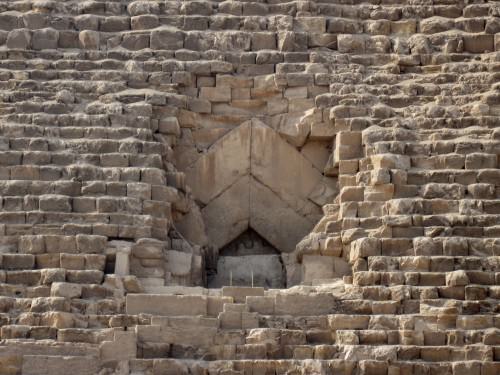
Entrance Passage, Great Pyramid of Giza
The ramp theory in either of these forms fails to explain how the pyramid was built while a much more satisfactory possibility rests right below the monument: the high water table of the Giza plateau. Engineer Robert Carson, in his work The Great Pyramid: The Inside Story, suggests that the pyramid was built using water power. Carson also suggests the use of ramps but in a much more cogent fashion: the interior ramps were supplemented by hydraulic power from below and hoists from above.Although the Egyptians had no knowledge of a crane as one would understand that mechanism the present day, they did have the shaduf, a long pole with a bucket and rope at one end and counter-weight at the other, typically used for drawing water from a well. Hydraulic power from below, coupled with hoists from above could have moved the stones throughout the interior of the pyramid and this would also account for the shafts and spaces one finds in the monument which other theories have failed to fully account for.
It is abundantly clear that the water table at Giza is still quite high in the present day and was higher in the past. Egyptologist Zahi Hawass, writing on his excavation of the Osiris Shaft near the Great Pyramid in 1999 CE, notes how "the excavation proved to be very challenging mainly due to the dangerous nature of the work caused by the high water table" (381). In the same article, Hawass notes how, in 1945 CE, guides at Giza were regularly swimming in the waters of this underground shaft and that "the rising water table in the shaft prevented scholars from studying it further" (379). Further, earlier attempts to excavate the Osiris Shaft - by Selim Hassan in the 1930's CE - and observations (though no excavation) of the shaft by Abdel Moneim Abu Bakr in the 1940's CE - also make note of this same high water table. Geological surveys have determined that the Giza plateau and surrounding region was much more fertile in the time of the Old Kingdom than it is today and that the water table would have been higher.
Considering this, Carson's theory of water power used in building the pyramid makes the most sense. Carson claims the monument "could only be constructed by means of hydraulic power; that a hydraulic transportation system was set up inside the Great Pyramid" (5). Harnessing the power of the high water table, the ancient builders could have constructed the pyramid much more reasonably than by some form of exterior ramping system.
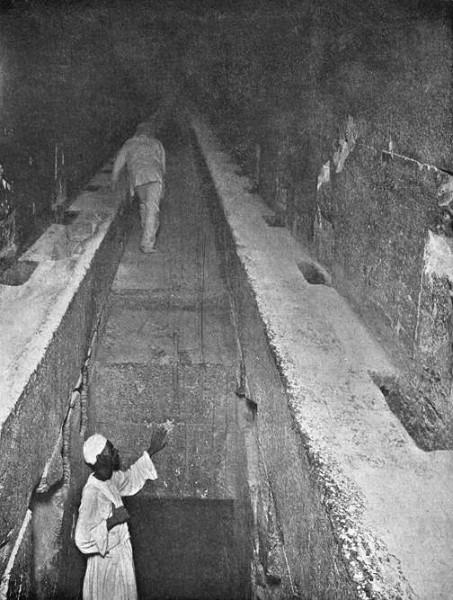
Interior Passage, Great Pyramid of Giza
Once the interior was completed, the whole of the pyramid was covered in white limestone which would have shone brilliantly and been visible from every direction for miles around the site. As impressive as the Great Pyramid is today, one must recognize that it is a monument in ruin as the limestone long ago fell away and was utilized as building material for the city of Cairo (just as the nearby city of ancient Memphis was). When it was completed, the Great Pyramid must have appeared as the most striking creation the Egyptians had ever seen. Even today, in its greatly weathered state, the Great Pyramid inspires awe.The sheer size and scope of the project is literally amazing. Historian Marc van de Mieroop writes:
The size boggles the mind: it was 146 meters high (479 feet) by 230 meters at the base (754 feet). We estimate that it contained 2,300,000 blocks of stone with an average weight of 2 and 3/4 tons some weighing up to 16 tons. Khufu ruled 23 years according to the Turin Royal Canon, which would mean that throughout his reign annually 100,000 blocks - daily about 285 blocks or one every two minutes of daylight - had to be quarried, transported, dressed, and put in place...The construction was almost faultless in design. The sides were oriented exactly toward the cardinal points and were at precise 90-degree angles. (58)
The workers who accomplished this were skilled and unskilled laborers hired by the state for the project. These workers either volunteered their efforts to pay off a debt, for community service, or were compensated for their time. Although slavery was an institution practiced in ancient Egypt, no slaves, Hebrew or otherwise, were used in creating the monument. Brier and Hobbs explain the logistics of the operation:
Were it not for the two months every year when the Nile 's water covered Egypt's farmland, idling virtually the entire workforce, none of this construction would have been possible. During such times, a pharaoh offered food for work and the promise of a favored treatment in the afterworld where he would rule just as he did in this world.For two months annually, workmen gathered by the tens of thousands from all over the country to transport the blocks a permanent crew had quarried during the rest of the year. Overseers organized the men into teams to transport the stones on sleds, devices better suited than wheeled vehicles to moving weighty objects over shifting sand. A causeway, lubricated by water, smoothed the uphill pull. No mortar was used to hold the blocks in place, only a fit so exact that these towering structures have survived for 4,000 years (17-18).

The Pyramids
The yearly inundation of the Nile River was essential for the livelihood of the Egyptians in that it deposited rich soil from the riverbed all across the farmlands of the shore; it also, however, made farming those lands an impossibility during the time of the flood. During these periods, the government provided work for the farmers through labor on their great monuments. These were the people who did the actual, physical, work in moving the stones, raising the obelisks, building the temples, creating the pyramids which continue to fascinate and inspire people in the present day. It is a disservice to their efforts and their memory, not to mention the grand culture of the Egyptians, to continue to insist that these structures were created by poorly treated slaves who were forced into their condition because of ethnicity. The biblical Book of Exodus is a cultural myth purposefully created to distinguish one group of people living in the land of Canaan from others and should not be regarded as history.
IT IS A DISSERVICE TO THEIR EFFORTS & THEIR MEMORY, NOT TO MENTION THE GRAND CULTURE OF THE EGYPTIANS, TO CONTINUE TO INSIST THAT THESE STRUCTURES WERE CREATED BY POORLY TREATED SLAVES.
THE GREAT PYRAMID AS TOMB
All of this effort went to creating a grand tomb for the king who, as mediator between the gods and the people, was thought to be deserving of the finest of tombs. Theories regarding the original purpose of the Great Pyramid range from the fanciful to the absurd and may be investigated elsewhere but the culture which produced the monument would have regarded it as a tomb, an eternal home for the king. Tombs which have been excavated throughout Egypt, from the most modest to the rich example of Tutankhamun 's - along with other physical evidence - make clear the ancient Egyptian belief in a life after death and the concern for the soul's welfare in this new world. Grave goods were always placed in the tomb of the deceased as well as, in wealthier tombs, inscriptions and paintings on the walls (known as the Pyramid Texts, in some cases). The Great Pyramid is simply the grandest form of one of these tombs.
Arguments against the Great Pyramid as a tomb cite the fact that no mummies or grave goods have ever been found inside.This argument willfully ignores the plentiful evidence of grave robbing from ancient times to the present. Egyptologists from the 19th century CE onwards have recognized that the Great Pyramid was looted in antiquity and, most likely, during the time of the New Kingdom (c. 1570-1069 BCE) when the Giza necropolis was replaced by the area now known as The Valley of the Kings near Thebes.
This is not to suggest that Giza was forgotten, there is ample evidence of New Kingdom pharaohs such as Ramesses the Great (1279-1213 BCE) taking great interest in the site. Rameses II had a small temple built at Giza in front of the Sphinx as a token of honor and it was Rameses II's fourth son, Khaemweset, who devoted himself to preserving the site. Khaemweset never ruled Egypt but was a crown prince whose efforts to restore the monuments of the past are well documented. He is, in fact, considered the world's "first Egyptologist" for his work in restoration, preservation, and recording of ancient monuments and especially for his work at Giza.
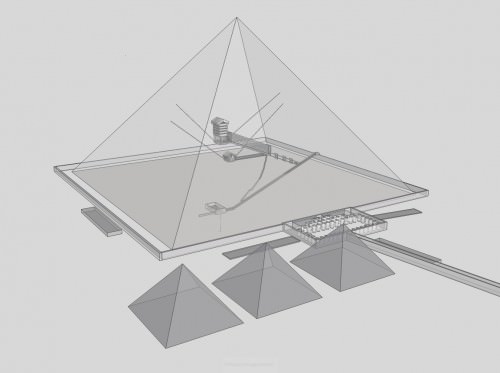
Interior Design, Great Pyramid of Giza
Further, work conducted on the Osiris Shaft - and other areas around the site - have shown activity during the 26th Dynasty of the Third Intermediate Period (c. 1069-525 BCE) and into the Late Period (c. 525-332 BCE). Giza was, therefore, an active site throughout Egypt's history but was not always given the kind of attention it received during the Old Kingdom. Herodotus, writing in the 5th century BCE, reported that the Great Pyramid had been looted and visitor's to the site in the modern day enter through the so-called Robbers Tunnel created c. 820 CE by Caliph al-Ma'mun seeking to recover whatever treasures the pyramid held inside. Tomb robbers before and after the caliph had also visited the pyramid prior to the excavations of the 19th century CE. Whatever treasures the pyramid may have held in the time of Khufu could have been removed at any time from the Old Kingdom onward.
THE GIZA PLATEAU
Following Khufu's death, his son Khafre (2558-2532 BCE) took the throne and began building his own pyramid next to his father's. The king Menkaure (2532-2503 BCE) came after Khafre and followed the same paradigm of building his eternal home at Giza. Khafre and Menkaure added their own temple complexes and monuments, such as the Great Sphinx of Giza under Khafre's reign, but these were on a smaller scale than that of Khufu's work. It is no accident or mystery as to why the Great Pyramid is the largest and the other two are progressively smaller: as the period of the Old Kingdom continued, with the government's emphasis on grand building projects, resources became more and more scarce. Menkaure's successor, Shepseskaf (2503-2498 BCE) had the resources to complete Menkaure's pyramid complex but could afford no such luxury for himself; he was buried in a modest mastaba tomb at Saqqara.
Still, Giza continued be regarded as an important site and funds were allocated as long as they were available for its upkeep.Giza was a thriving community for centuries with temples, shops, a market place, housing, and a sturdy economy. Individuals in the present day speculating on the lonely, deserted, mystical outpost of Giza ignore the evidence of what the complex would have been like for most of Egypt's long history. The present day understanding of the plateau as some isolated outpost of monuments encourages theories which do not align with how Giza actually was when those monuments were constructed.Theories suggesting mysterious tunnels beneath the plateau have been debunked - yet still persist - including speculations concerning the Osiris Shaft.
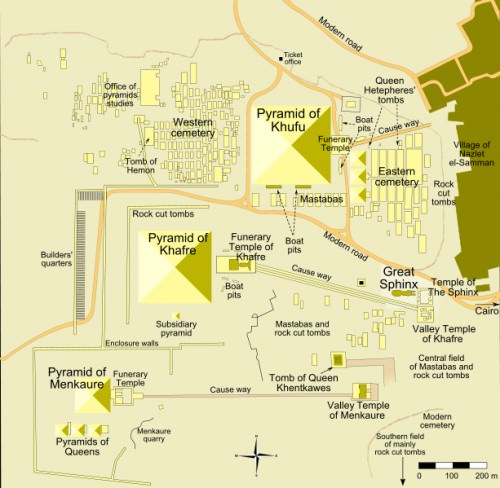
Map of the Monuments at Giza
This complex of underground chambers was most likely dug, as Hawass contends, in honor of the god Osiris and may or may not have been where the king Khufu was originally laid to rest. Herodotus mentions the Osiris Shaft (though not by that name, which was only given to it recently by Hawass) in writing of Khufu's burial chamber which was said to be surrounded by water.Excavations of the shaft and the chambers have recovered artifacts dating from the Old Kingdom through the Third Intermediate Period but no tunnels branching out beneath the plateau. Osiris, as lord of the dead, would certainly have been honored at Giza and underground chambers recognizing him as ruler in the afterlife were not uncommon throughout Egypt's history.
Although the Great Pyramid of Giza, and the other smaller pyramids, temples, monuments, and tombs there, continued to be respected throughout Egypt's history, the site fell into decline after the Roman occupation and then annexation of the country in 30 BCE. The Romans concentrated their energies on the city of Alexandria and the abundant crops the country offered, making Egypt into Rome 's "bread basket", as the phrase goes. The site was more or less neglected until Napoleon's Egyptian Campaign of 1798-1801 CE during which he brought along his team of scholars and scientists to document ancient Egyptian culture and monuments. Napoleon's work in Egypt attracted others to the country who then inspired still others to visit, make their own observations, and conduct their own excavations.
Throughout the 19th century CE, ancient Egypt became increasingly the object of interest for people around the world.Professional and amateur archaeologists descended upon the country seeking to exploit or explore the ancient culture for their own ends or in the interests of science and knowledge. The Great Pyramid was first fully excavated professionally by the British archaeologist Sir William Matthew Flinders Petrie whose work on the monument lay the foundation for any others who followed up to the present day.
Flinders Petrie was obviously interested in exploring every nuance of the Great Pyramid but not at the expense of the monument itself. His excavations were performed with great care in an effort to preserve the historical authenticity of the work he was examining. Although this may seem a common sense approach in the modern day, many European explorers before Flinders Petrie, archaeologists professional and amateur, brushed aside any concerns of preservation in pursuing their goal of unearthing ancient treasure troves and bringing antiquities back to their patrons. Flinders Petrie established the protocol regarding ancient monuments in Egypt which is still adhered to in the present day. His vision inspired those who came after him and it is largely due to his efforts that people today can still admire and appreciate the monument known as the Great Pyramid of Giza.
Ten Noble and Notorious Women of Ancient Greece › Antique Origins
Ancient Civilizations
There were, no doubt, many notable women in ancient Greece, but history books are usually silent on female accomplishments. According to the historian and novelist Helena P. Schrader, this is because, " Herodotus and other ancient Greek historians are far more likely to mention Persian queens than the wives of Greeks – not because Persian women were more powerful than their Greek counterparts, but because Persians had several wives, and so it was sometimes useful to record by which of them a certain Persian figure had been born. Since Greeks had only one legitimate wife, there was no need for such clarification when it came to prominent Greek citizens". Every so often, however, certain women performed deeds that the male writers of history simply could not ignore. Women such as Queen Gorgo of Sparta (c. 490 BCE) and Aspasia of Athens (470-400 BCE) have always been well known for their own achievements and for their association with famous men like Leonidas and Pericles, but there were many more who led interesting lives and performed heroic acts and who remain lesser known in the modern day.

Aspasia Surrounded by Greek Philosophers
HYDNA OF SCIONE
Hydna of Scione was trained to swim by her father, Scyllis of Scione, a diving instructor and expert swimmer who taught the art of swimming for a living. He instructed his daughter from a young age, and she became well known for her ability to dive deeply and swim long distances. When the Persians invaded Greece in 480 BCE, they sacked Athens and marched across the mainland after defeating the Greeks at Thermopylae. The Persian navy then sought to destroy the rest of the Greek force in the naval battle at Salamis. If the Persians won at Salamis, Greece would be lost. Hydna and her father dove beneath the Persian ships and cut their moorings, causing these ships to drift and run aground or damage other vessels. This feat is even more impressive when one considers that, in order to perform it, Hydna and Scyllis had to swim ten miles into the sea in the middle of a storm. Their story comes from the Greek historian Pausanius in his Description of Greece, 10.19.1, and he further relates that, for their heroism, statues of them were erected at Delphi following the Persian defeat.
ANYTE OF TEGEA
Anyte of Tegea (3rd century BCE) was one of the female poets listed by Antipater of Thessalonica as one of the Nine Earthly Muses (with others such as Sappho of Lesbos and Telesilla of Argos ). Anyte was among the first poets of Greece to emphasize the natural world in her work (as opposed to supernatural subjects such as the gods) and to write the epigram. She was best known for her epitaphs, especially those for animals. These were not her only artistic contributions, however, and her poetry was so impressive that it was compared in ancient Greece to the works of Homer. Her epitaphs for pets were very popular, and she was much sought after to write them. An example is this one for a pet dog:
You died, Maira, near your many-rooted home at Locri, swiftest of noise-loving hounds;A spotted-throated viper darted his cruel venom into your light-moving limbs.
Another poem is written as an epitaph for a locust and a cicada for whom a young girl constructed a tomb :
Myro, a girl, letting fall a child's tears, raised this little tomb for the locust that sang in the seed-land and for the oak-dwelling cicada; implacable Hades holds their double song.
More of Anyte's works survive in the present day than any other female Greek poet and are still admired as they were by her contemporaries. She is thought to have run a school for the study of poetry in the Peloponnesus though the exact location is unknown. Anyte was later attached to a legend in which it was said she once had a dream that the god of healing, Asclepius, told her to deliver a message to a man named Phalysius who was going blind. She woke and found a sealed writing tablet she had never seen before resting by her bed and, at her own expense, traveled a significant distance to deliver it to Phalysius. His eyes were healed, and when he opened the message, it instructed him to give Anyte 2,000 gold coins, which he promptly did. Whether there was any truth to the story is not as important as the message it would have imparted to its hearers: when the gods tell one to do something, one should do it.
TELESILLA OF ARGOS
Of the poets listed with Anyte in Antipater's list of earthly muses is Telesilla of Argos (5th century BCE) who, though famous for her poetry, became more so for defending her home city against the invading Spartans in 494/493 BCE. After Cleomenes I of Sparta decimated the Argive forces at Sepeia and, later, at the Sanctuary of Argus, he marched on the city of Argos. Telesilla took down the ornamental arms from temples in the city, raided the armory for whatever was left, and equipped a force of the city's women with arms and armor. She then organized the city for defense and marched out to meet the Spartans, inflicting heavy losses. Cleomenes recognized that he was facing an impossible situation: if he defeated her, he would have no honor in slaughtering women, while if they defeated him, Sparta would have been beaten by a band of girls, so he prudently withdrew his army and Argos was saved. Modern-day historians still debate the truth of this account, but it was repeated by many ancient sources and is considered entirely plausible by a number of scholars today.
PHRYNE OF THESPIAE
Phryne of Thespiae (c. 370-c. 316 BCE) was a famous courtesan of Athens, best known for the court case she won by baring her breasts. Her actual name was Mnesarete ("commemorating virtue"), but she was called Phryne ("toad") because of the yellow complexion of her skin. Ancient writers such as Athenaeus praise her extraordinary beauty, and she was the model for many artists and sculptors in Athens, including chiefly posing as Aphrodite (the existing statue, Aphrodite of Knidos, is thought to be modeled on her). The court case surrounded the charge of impiety, and it has been suggested that, whatever Phryne did, it had something to do with the Eleusinian Mysteries (initiation rites for the cult of Demeter and Persephone ). It could be, like Alcibiades, that she had taken the sacred Kykeon (potentially psychoactive drink) for a private party with friends, but this is only conjecture (though, it seems, not out of character). Her lover Hypereides, a famous orator, defended her in court and spoke eloquently, but it seemed as though the judges were going to condemn her. At this point Hypereides disrobed Phryne, and the judges were so struck by her beauty that she was acquitted. The truth of this story, like that of Telesilla's defense of Argos, has been debated for centuries. Some claim that the earliest account of the trial makes no mention of Phryne disrobing and that it was a later invention created to mock the Athenian court; some claim that it was Phryne herself, not Hypereides, who removed her clothes and that she also undid her hair to show herself in the likeness of Aphrodite. Whatever happened, she was acquitted and went on living a life of luxury as one of the most beautiful and sought-after women of Athens. She became wealthy enough to live as she pleased and even offered to re-build the walls of Thebes, which Alexander the Great had destroyed, if the people would consent to her inscription reading, "Destroyed by Alexander, Restored by Phryne the Courtesan", but the Thebans refused her offer.

Aphrodite of Knidos
ARETE OF CYRENE
Arete of Cyrene (4th century BCE) was the daughter of the hedonist philosopher Aristippus (c. 435-356 BCE) and grew up influenced by his teachings. There is some dispute among historians as to whether it was Aristippus or his grandson of the same name who founded the Cyrenaic School but, since ancient sources claim that Arete took over the school upon Aristippus' death, it would appear to be the former. Like her father, she is said to have held to the philosophy of "I possess, I am not possessed", by which she meant that one could have as many worldly goods as one wished as long as one's life was not controlled by those possessions. One could, for example, have a house and many beautiful objects furnishing and adorning it, but one should recognize such things as possessions which, perhaps, once belonged to another before and will certainly belong to someone else after one's death or change in circumstance. One should, therefore, pursue pleasure and enjoy the things of this world without allowing those things to control one's life and freedom of movement. Arete of Cyrene is said to have written over 40 books, none of which survive in the present day. She also appears to have been a single mother who raised Aristippus-the-Younger in the hedonistic philosophy and home schooled him. He would later take over the operation of the Cyrenaic School after Arete's death.
HIPPARCHIA OF MARNEIA
Another female philosopher was Hipparchia of Marneia, whose austere life and teachings stood in complete contrast to the hedonism of Arete of Cyrene. Hipparchia came to Athens as a teenager with her family and fell in love with the Cynic philosopher Crates of Thebes who lived there. Her brother, Metrocles, was one of Crates' students and introduced them.Hipparchia was drawn to the simplicity of the Cynic lifestyle, which emphasized complete honesty, independence, rejection of luxury and pleasure, and living life in accordance with nature. Hipparchia became so deeply attached to Crates himself that she rejected the suitors her parents encouraged and said that she would either marry Crates or kill herself. Crates was, at this time, an elderly man, and her parents asked him to convince Hipparchia to marry someone her own age and live a more traditional life. Crates is said to have disrobed before Hipparchia and said to her, "Here is the bridegroom and these are his possessions - choose accordingly", which only made Hipparchia love him more. They consummated the marriage in public on the porch of a building in downtown Athens. This was in keeping with the Cynic philosophy that one should shamelessly do in public what one does in private because, if there is nothing wrong with what one is doing, there should be no shame in performing the action in front of others. She wore men's clothes and traveled and taught with Crates, bearing him two children.When he died, she may have taken over teaching his students in Athens and was said to have written a number of books which are no longer extant. She is the only female philosopher included at length in Diogenes Laertius' work The Lives and Opinions of Eminent Philosophers (3rd century CE) alongside men like Socrates and Plato.
TIMYCHA OF SPARTA
Timycha of Sparta (4th century BCE) was yet another female philosopher who traveled with her husband, Myllias of Croton, and a band of Pythagoreans. She became a symbol of courage in the face of adversity. The philosophy of Pythagorasemphasized the immortality of the soul and the sacredness of life and so Pythagoreans were strict vegetarians but were prohibited from eating beans. The precise reason for this is unclear, but it is thought that perhaps they believed that the shape of the bean, especially the fava bean, served as a conduit for souls to return to earth. Reincarnation (known to them as the Transmigration of Souls) was a fundamental belief of the Pythagoreans, and it was thought that the souls of the living came back from the underworld through the earth and, especially, through bean fields. This knowledge, like most of Pythagoras' teachings, was reserved only for those who were initiated into the mysteries and was not to be revealed to just anyone. One day, Timycha (who was six-months pregnant at the time) and her band of philosophers were invited to the court of Dionysius the Elder to discuss their philosophy but, following the tenets of their belief, they rejected the tyrant's invitation because they did not believe he was true in his intentions. Dionysius, insulted, sent some of his soldiers to bring them forcibly to the court.The philosophers could have easily escaped by running through a nearby bean field but, because of their religious beliefs, they could not do this and so were all killed resisting the soldiers except for Timycha and Myllias. These two were captured and brought before Dionysius. He was intrigued when he heard they refused to enter the bean field to escape and questioned Timycha repeatedly. When she would not answer him, he had her tortured and then brought back to him where she is said to have bitten off her tongue and spat it out at his feet in defiance. What happened to her and Myllias after that incident is not known, but they were most likely executed. She was referenced by later Pythagoreans as a model of courage and martyr for the cause.
PHILAENIS OF SAMOS
Philaenis of Samos (4th century BCE) was a courtesan who became famous for writing a manual on lesbian sexual positions and the proper etiquette for courting a member of the same or opposite sex. Her work no longer survives but is cited by later authors. The term "lesbian" to denote a homosexual woman did not exist in ancient times and only originates later when people began to identify homosexual women with Sappho of the island of Lesbos because of her intimate female-oriented love poems (although, in fact, there is no other evidence that Sappho was homosexual). In Philaenis' time, a gay woman was known as a tribad (from the word "tribo" meaning "to rub, referring to women's sexual activity with each other). Her work is said to have covered the best sexual positions, perfumes, cosmetics, means of inducing abortions, the art of kissing, and the art of seduction, including how to make successful passes. Written in the style of The Histories of Herodotus - a kind of History of Sex - her book was very popular and widely read even though people seem to have publicly condemned it. Their disapproval had less to do with the subject matter than that a woman would had written it. The writer Vicki Leon, author of Uppity Women in Ancient Times, writes:
Isn't it always the case - the yearbook with your dorky picture survives for decades but the love-letters get thrown out! It was the same in ancient times: we have landfill amounts of dull material from dozens of male philosophers. But what about the works of steamy writer Philaenis? A bare nothing. And a real pity, too, because she gained notoriety for writing the first illustrated book on lesbian sexual matters - in verse no less (185).

Agnodice
AGNODICE OF ATHENS
Philaenis' work may have been considered scandalous at the time but not nearly as shocking as the life of Agnodice (4th century BCE), who was the first female doctor in ancient Athens and whose challenge to the male-dominated profession changed the laws regarding women practicing medicine. Women had always been allowed to perform the services of midwife and could even attend patients, until it was alleged that they were helping their female patients procure abortions. After that, women were not allowed to practice medicine, and the penalty for doing so was death. Agnodice cut her hair and disguised herself as a man in order to study medicine and even traveled to Egypt, where women were held in higher regard and could be doctors, in order to learn her craft. Still in her guise as a man, she returned to Athens and began to treat people. She became so popular among female patients (who knew she was a woman) that she was accused by a group of men (who thought she was a man) of seducing them. She was put on trial in the Areopagus and, in defending herself against the charge, revealed she was a woman. The men then threatened to execute her for breaking the law by practicing medicine while pretending to be a man. She was saved by her female patients who shamed the court into acquitting her. It seems as though they pointed out how Agnodice had been successfully practicing medicine for some time now and that the male doctors were simply jealous. After her trial, the laws were changed so that women could practice medicine equally with men.
THARGELIA OF MILETUS
Another woman of note was the courtesan Thargelia of Miletus who, according to Athenaeus, was remarkably beautiful, clever, and charming. She was married 14 times in her life although the reason for, and duration of, these unions is not recorded. She was a pro-Persian Greek in an anti-Persian culture and, according to Plutarch, swayed many influential men to consider the Persian cause seriously during the time when Persia was moving to conquer Greece (480 BCE). She was so seductive that, again according to Plutarch, no man could resist her and she was able to draw from them information which she then passed on to the Persians. Accordingly, she became known as a conspirator and enemy to the cause of Greek freedom, and her name was afterwards synonymous with "traitor" in the same way that the name of Benedict Arnold is in the modern day in the United States of America. She lived in Thessaly and had many clients and, through them, she spread the Persian agenda throughout the region. She was the antithesis of women like Hydna of Scione or Gorgo of Sparta who risked their lives or lost their husbands in the cause of Greek freedom. At the same time, however, it should be noted that there were many Greeks who favored Persian rule, as it seemed more stable than the constant squabbling and fighting between the Greek city-states, and so it was not as though Thargelia was a lone voice for the Persian cause at the time.
There are many other impressive women of interest in the ancient histories of Greece who are also mentioned by the writers of their time. Some were able to rise above the restrictions society placed upon women (as in the case of Arete or Telesilla) and others were able to work within the system to live as they wanted to (such as Phryne and Thargelia). Although the ancient historians chose not to dwell on the accomplishments of women, these women had such an impact on their society that there was no way they could be ignored.
LICENSE:
Article based on information obtained from these sources:with permission from the Website Ancient History Encyclopedia
Content is available under License Creative Commons: Attribution-NonCommercial-ShareAlike 3.0 Unported. CC-BY-NC-SA License